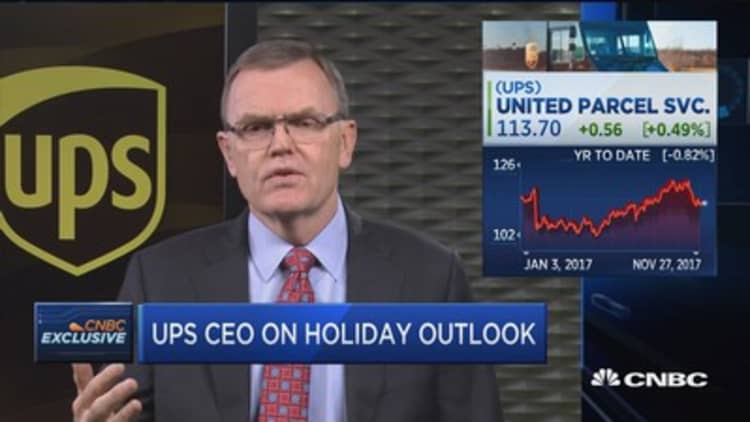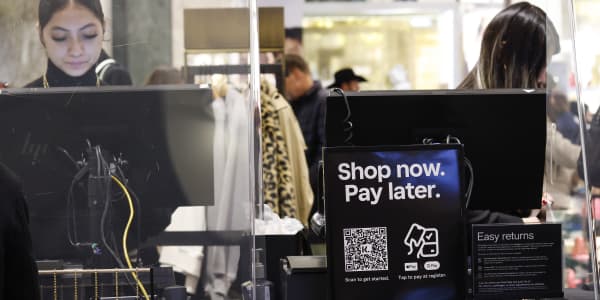Another Black Friday is in the books. But the holiday season is hardly over for retailers.
Many companies have now shifted resources to focus on their digital operations on Cyber Monday, an annual internet shopping phenomenon that got its start in the early 2000s.
Retailers including Amazon, Best Buy, Target and Wal-Mart are doling out exclusively digital deals with extraordinary markdowns. Target, for example, is slashing 15 percent off prices across its entire website.
Meantime, shoppers are expected to spend more than ever online — $6.6 billion on Monday alone — according to Adobe Insights — an increase of 16.5 percent from last year's sales.
"Consumers are conditioned to waiting for those key shopping moments, and this year is no exception," Mickey Mericle, vice president of Adobe's Marketing and Insights, said about Cyber Monday.
"We're seeing significantly higher growth in online spend this year," Mericle said. "Every day in November has been a billion-dollar day, and we're predicting that we have more than twice the number of $2 billion shopping days this holiday season — that's an incredible milestone."
If you're one of the millions of Americans planning to make a purchase online this holiday season, you likely haven't considered what happens behind the scenes, to get that package to your doorstep. The process is still quite labor intensive, in many instances, and involves year-round planning to ensure all the pieces come together.
While some smaller brands are able to fulfill online orders entirely with their own resources, many companies partner with third-party logistics operators such as Pennsylvania-based Radial, Geodis in Europe or Fulfillment by Amazon.
These companies serve as intermediaries between the retailer and the customer. They hold inventory, prepare an order once it's received, and then work with a transportation provider such as UPS or FedEx to get the package to you.
"We've gotten off to a good start ... and are comfortable with where we are," UPS CEO David Abney told CNBC's "Squawk on the Street" Monday morning, reflecting on business over the weekend. "What's most important to customers is making sure they get a delivery they can depend on."
This holiday season, UPS expects to make about 750 million deliveries, a 7 percent increase from 2016. The U.S. Postal Service is predicting it will deliver about 850 million packages, while FedEx expects as many as 400 million packages before the New Year.
And for the first time, UPS this year is tacking a surcharge onto packages shipped close to Black Friday and the week prior to Christmas, aiming to soften order flow around peak periods.
"We get a lot of compression up until the very end of the holiday season," said Stefan Weitz, executive vice president of Radial's technology services. Last-minute shoppers can make the job more difficult, he said, but "every doll has to be delivered" before Christmas.
New Jersey-based Dotcom Distribution is another e-commerce partner that boasts local recognition. Some of Dotcom's past retail clients include beauty brand Birchbox and fashion retailers Intermix and Vineyard Vines. Currently, Dotcom is fulfilling orders for companies including Bluemercury, Bliss, Glossybox, Adore Me and Ashley Stewart.
Heading into the peak of the holiday shopping season, Dotcom runs operations 24/7 at its 400,000-square-foot warehouse in Edison. The building's landlord, Prologis, has watched its stock climb more than 25 percent this year because of renewed warehouse demand.
"I like to think of this as organized chaos," Dotcom CEO Maria Haggerty told CNBC during a tour of the facility. Haggerty, once an accountant, is also one of Dotcom's founders.
Upon entry, the warehouse spans aisles and aisles, with shelves reaching as high as the building's 40-foot ceilings, each stacked with merchandise. Retailers are sectioned off throughout the floor, keeping inventory organized. There's also a corner dedicated to handling returns.
"The retailers we work with have ... outgrown either their garage or basement and are looking for someone who has the processes or procedures in place to help them scale," Haggerty said. "We guide them along the way, we teach them and they teach us."
Just days before Cyber Monday, employees are spread across the floor packing boxes — one group was seen assembling DNA kits for MyHeritage, an item Haggerty said has "exploded" suddenly, driven by consumers' interest. Others were riding around on one of Dotcom's 40 forklift trucks, carrying pallets of packages to their respective drop zones.
"Amazon set the bar for e-commerce, but Wal-Mart had already set the bar for distribution," Haggerty said about the retail landscape today.
But, she added, Dotcom differentiates itself from larger, more automated fulfillment centers in that it can personalize packages. For example, one client requests that a spritz of perfume is sprayed in all of its boxes before assembly.
There are certain human tasks that "robots" won't ever be able to take away, Haggerty said. But over time she does expect the industry's labor model to evolve, as it makes sense.
To be sure, Haggerty and Weitz agreed that finding temporary labor to fill additional positions on the floors of fulfillment centers durig the holidays can be a challenge.
The labor market is only getting tighter — with retailers vying for the same seasonal employees — as wages rise. Radial tries to offer more flexible shifts and advertises employee events, even luring college students who are looking for extra cash over the holidays.
"Fulfillment is a very skinny-margin business, and the biggest cost of course is labor," Weitz said. "That's the one thing we spend a lot of time on this year — building out real-time models for our labor."
Radial and Dotcom can at least take pride for getting into the market and securing space at the right time.
"While there is a glut of malls, there aren't nearly enough warehouses across the U.S. to support internet retailers like Amazon," Jefferies analyst Jonathan Petersen wrote in a note earlier this year. "[R]etail sales are not in decline, but rather shifting toward e-commerce retailers who require large amounts of warehouse space."
WATCH: UPS CEO talks fulfillment around the holidays





